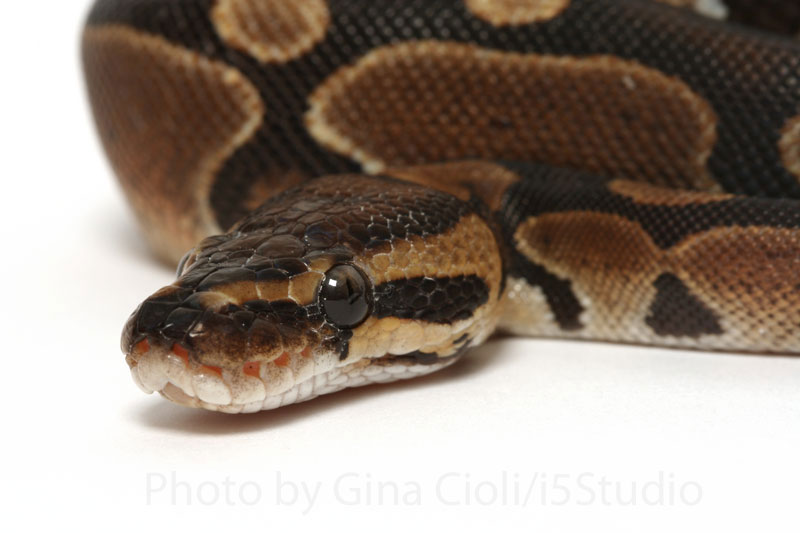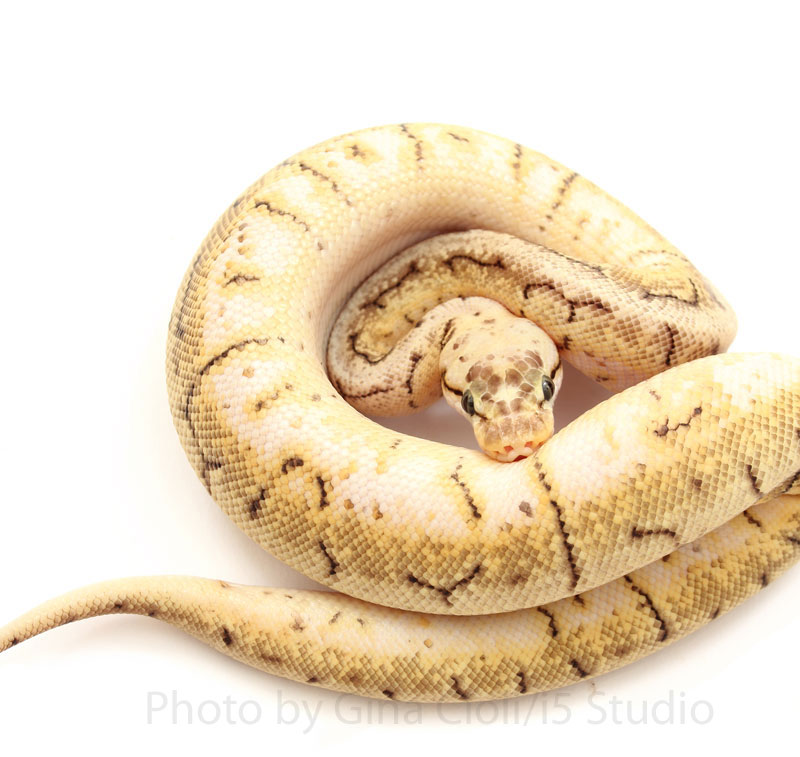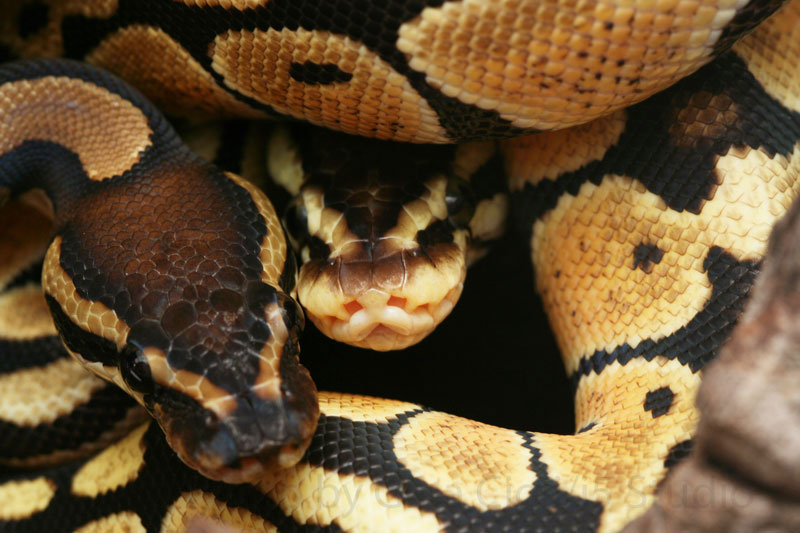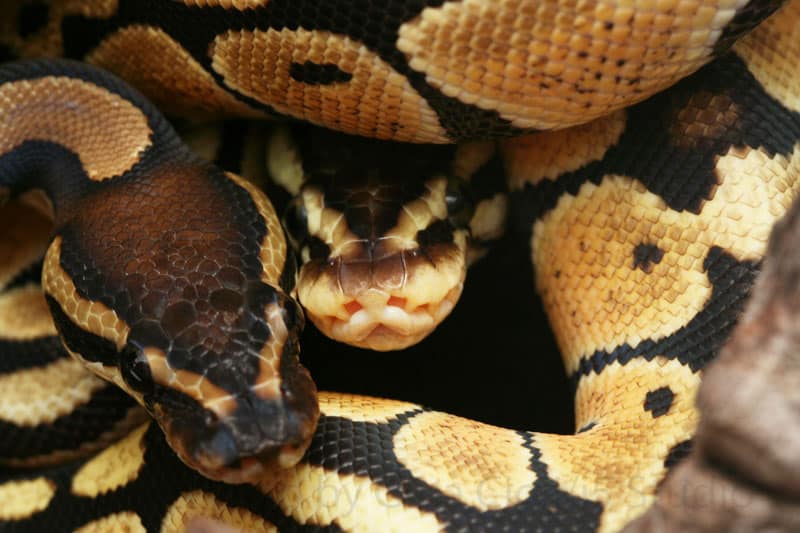The ball python has become the most popular pet snake in herptoculture.
At the beginning of the 1990s, the ball python (Python regius) was a snake that everyone in town danced with, but no one wanted to take to the prom. Despite their perfect size and temperament, attractive colors and pattern, they were inexpensive and common snakes. Nearly everyone started out with ball pythons and boa constrictors as their first exotic, tropical snakes, but the roving eyes of young snake keepers would nearly always begin to look at other snakes that seemed more worthy of their lusting obsessions. It’s interesting now to see how at the end of the 1990s, ball pythons have become one of the most high profile and popular snakes in all of herpetoculture. It’s like looking back and suddenly realizing that the kid next door who you snubbed has grown up to become an international super model.
We started to collect ball pythons in 1989, and until 1991 we bought beautiful ball pythons from the importers for $5 extra. We found all manner of color and pattern anomalies, beautiful ball pythons that were “in the trade” and about to be sent to some small pet store to sell for $15 or $20. But it all changed and changed quickly in 1992, when the first captive-bred albino ball pythons became available for $7,500 each. Since then, every single one of the tens of thousands of ball pythons that are annually imported has been carefully scrutinized to see if it’s different, if it has some additional market value because of some quirk of pattern or color unique to that snake.

Photography by Gina Cioli/i5 Studio
The ball python is one of the most popular pet snakes in the trade.
In 1990, there were ball pythons, striped ball pythons, two piebald ball pythons and one albino ball python. Today there are axanthic, clown, labyrinth, jungle, pastel-jungle, tiger, spider, banded, black, black-backed, ghost, narrow-striped, wide-striped, ringer, black-and-white, high-gold, tyrosinase-positive (t+) caramel albino, tyrosinase-negative (t-) albino, leucistic, piebald (of course) and who knows what else. There are dozens of web pages and entire sites devoted to ball python variations. This past week, three keepers sent us photos of new and different varieties of ball pythons that (as incredible as this may sound) don’t even have names yet.
Still today, the genetic basis and patterns of inheritance of many of the identified variations are not known. Of those that are known, some of the variations seen in ball python appearance are apparently random individual variation and not inheritable, some are polygenetic traits created by the interaction of multiple genes, and some are the results of single mutations. Determining which is which is achieved by selective breeding.
Through the early 1990s, there were very few breeding pairs of ball pythons in captivity in the United States. One reason was that prior to that time the trade in ball pythons mostly involved adult snakes. As is true for most of the python species, wild-caught adult female ball pythons are notoriously difficult to breed in captivity, particularly in their first three to four years in captivity, although this was not realized at that time. Of course, the fact that ball pythons were then inexpensive imports, as they are today, also retarded any serious attempts at establishing breeding projects for this species. Even today, it’s cheaper to buy imported normal-colored ball python babies than to breed them. If, in fact, the captive breeding of normal-colored ball pythons does have any real value to science, conservation or to American small business, this anomaly of international trade someday must be corrected.

Photo by Gina Cioli/i5 Studio
Today there are a variety of ball python morphs, including axanthic, clown, labyrinth, jungle, pastel-jungle, tiger, spider, banded, black, black-backed, ghost, narrow-striped, wide-striped, ringer, black-and-white, high-gold, tyrosinase-positive (t+) caramel albino, tyrosinase-negative (t-) albino, leucistic, piebald (of course) and many others.
In discussing the ball python variations that have been investigated or are commercially available, it’s first necessary to establish what normal ball pythons are supposed to look like. Some ball python fanciers describe ball pythons as pale snakes with dark markings, while others see them as dark snakes with large pale blotches. The dark markings of most ball pythons are chocolate brown, black-brown or black; the pale markings of the average adult ball python are medium brown. The pale markings of hatchlings or juveniles are often yellow, gold or yellowish-brown. The bellies of most ball pythons are off-white or pale gray, with some gray smudges.
The most commonly observed ball python pattern is a dark back and dark upper head surface. On each side, spaced along the length of the neck and body, are 15 to 25 large, pale, rounded blotches, usually open on the bottom, connected with and shading to the paler belly coloration. The blotches are separated by vertical dark interspaces that connect to the dark back. Each pale lateral blotch may have one or two small dark spots in the upper portion of the blotch; some populations of ball pythons do not have these small spots at all, while in other populations there may be numerous small dark freckles in the pale lateral blotches. Down the center of the back there is a series of longitudinally elongated oval pale blotches of irregular lengths that typically are more yellowish in color than the lateral pale markings. The posterior body and tail are dark with a well-defined pale vertebral stripe that stops short of the tip. The end of the tail is dark with a pale tip. The sides of the head are pale, and there is a dark line, usually two scales in width, from the angle of the jaw forward through the eye to the nostril. The eyes are so darkly pigmented that the pupils may be difficult to discern from the dark irises.
At this time, there are two accepted types of albino ball pythons. The best known and the first to be bred in captivity is the classic albino that was first bred by Bob Clark. This albino has a normal pattern. The pale pattern elements are white and the dark pattern elements are orange-gold or dark yellow in hatchlings and yellow in adults. These albinos fit the description of tyrosinase-negative (t-) albinism, and have pink tongues and pink eyes. This type of albinism has been bred through three generations and is inherited as a simple recessive trait.
The first impression of a caramel albino ball python is of a richly colored yellow snake. The pattern is normal. The pale pattern elements are yellow or yellow-gold, the dark pattern elements are a medium purplish-gray, sometimes bordered in white on the lower sides of the body. This is likely a form of tyrosinase-positive (or t+) albinism, although that has yet to be conclusively demonstrated. Caramel albinos have pale stomachs and pink tongues. They have dark eyes that reflect a deep ruby red when a light is shined in them (a normally pigmented eye appears black and reflects no light when a light is shined in it).
We believe that this type of albinism is inherited as a simple recessive trait, but that has not been demonstrated. This is a rare mutation-only two or three true caramel albino ball pythons have been collected in the wild, far fewer than the number of wild-caught t- albinos. At the time of this writing, there are eggs incubating from which F2 caramel albinos are expected to hatch. This type of albinism has been observed in blood pythons, Sumatran short-tailed pythons and reticulated pythons; at the time of this writing, it has been shown to be inheritable as a simple recessive trait only in blood pythons.
The condition of piebald is one of the most unusual of all the ball python color and pattern variations. Piebald ball pythons are astounding, almost shocking, to behold. The head and anterior neck has normal color and pattern. The body of a piebald has large areas of milk-white that separate areas of normal color. The normally colored areas on the body typically have an anomalous pattern of paired dark stripes or paired elongated blotches. The amount of white on the bodies of piebald ball pythons may vary from about 30 percent to 90 percent of the total surface of the body. We’ve heard rumors that there is a white-headed piebald ball python, but we are skeptical that such an animal exists. The condition of piebald in ball pythons has been demonstrated to be inherited as a simple recessive trait.
Ringer ball pythons are, in essence, 5 percent piebald. They are normally pigmented and patterned, except that they have a white blotch on the posterior body, usually at the level of the kidneys. Usually it is no more than a white spot on the side, but a few “ringers” actually have a thin white ring all or part way around the body. They are identified usually in hopes that their condition is related to the piebald trait. The inheritance of the ringer pattern is unknown.
The axanthic ball python looks like a black-and-white photograph of a ball python. The pattern is normal. They have no yellow or brown coloration, and have only white, gray and black color at all ages. This trait has been bred to the F2 generation and has been conclusively demonstrated to be inherited as a simple recessive trait. In fact, there are two lineages of axanthic ball pythons. The hatchlings of the two lineages are nearly indistinguishable, but the adults in the second lineage develop some brown coloration in their pale pattern as they mature. This second type of axanthic condition also is inherited as a simple recessive trait.
Similar to the axanthic trait are the black-and-white ball pythons. We have seen three wild-caught ball pythons with this condition, one youngster and two older adults. They are patterned normally. It appears that, as hatchlings, these snakes are black and white only. As they age they begin to replace the white areas of pattern with dark charcoal-gray smudgy pigment, and as adults they are very dark gray animals. To our knowledge, these have never been bred in captivity.

Photo by Gina Cioli/i5 Studio
Ball pythons tend to be very shy snakes.
Wild-caught normal-colored ball pythons with beautiful pale vertebral stripes from head to tail have been bred together to produce clutches of normally patterned offspring. This does not necessarily preclude that all such conditions of pale vertebral stripes are not inheritable traits. But it does at least mean that not all pale vertebral stripes are the result of the same mutation. There is no recognized proven lineage of inheritable pale vertebral striping.
Black-backed ball pythons are normally colored ball pythons that are lacking any pale vertebral markings. When black-backed ball pythons are bred together, they produce similar offspring. Still, because of the fact that there is a complete range of variation in the character of dorsal vertebral blotches, ranging from a vertebral stripe, through decreasing numbers and sizes of pale vertebral blotches, to the extreme of “black-back,” we are unconvinced that the condition of black-back is a simple recessive trait. To prove such, it will be necessary to create F1 het-black-back ball pythons by breeding a black-back with a normal, and then breed these F1s together to produce F2s. If 25 percent of the offspring in the resulting F2 clutch are black-backs, then it can be stated with a high degree of certainty that this is a simple recessive trait.
Clown ball pythons are near and dear to our hearts. We have collected four of the five known wild-caught specimens. They have anomalous color and pattern. They have a very unusual mottled head pattern and a wide dark stripe down the back with little or no lateral dark pattern. The pale pattern elements are yellow or yellow-gold and are without any of the fine stippling of tiny melanin dots that darken the overall appearance of normal ball pythons. As hatchlings, their dark pattern elements are blackish brown, but as they mature, the dark pattern becomes increasingly pale, eventually becoming a pale yellow-brown. As is characteristic of albino ball pythons, the shed skins of clown ball pythons are completely without a trace of dark pattern. Clown ball pythons have been bred with normal ball pythons to produce normal-appearing F1 “het-clowns.” At the time of this writing there are F2 eggs incubating that will demonstrate if this is a simple recessive mutation, the culmination of five years of work.
Ghost ball pythons are pale with a normal pattern. They have a sort of satiny faded look. Some keepers describe them as hypomelanistic (with less than normal dark pigment), while others think of them as xanthic (with more than average yellow pigment). Some ghost ball pythons are normally colored. The field mark of ghost balls is that the top of the head is paler than average; in hatchlings the top of the head is a faded purplish brown and in some adults a medium brown or greenish brown. In 1994 we bred two wild-caught ghost ball pythons together to produce a litter of normal babies. This winter we bred the two pairs of 4 1/2-year-old “double-hets” to produce two clutches of eggs. At the time of this writing, one of the clutches has hatched to produce three pale ghosts, one dark ghost and two normal babies. So we don’t know exactly what is going on at this time, but we can say that there are at least two different recessive traits that are both referred to as “ghosts.”
Black ball pythons have a normal pattern that is darkened by a dense wash of black pigment over the entire body. There are two or three black balls in captivity that are nearly black animals, but most appear as unusually dark, normally patterned animals. Every year a few black balls are gleaned out of the tens of thousands of normal ball pythons that are imported. It’s always seemed to us that black ball pythons are smaller snakes with large eyes, and we were hopeful that this melanistic appearance would be a simple recessive trait due to a single mutation. At the least, we thought that it was some unidentified geographic variation. We expected this to be an inherited trait. However, this year we bred two very black ball pythons together to produce a clutch of pretty normal-looking babies. (Hmmm, maybe they’ll darken with age.)
The conditions of labyrinth, jungle and pastel-jungle are all similar in appearance. As hatchlings, they are bright yellow-gold animals with black markings. The pale pattern loses its intensity with age, and turns to pale brown in jungles. All three have pale eyes and an unusual pale marking on the top of the head. The dark pattern is aberrant in all three, but labyrinth balls have big black blotches on their sides.
The inheritance patterns of the conditions of labyrinth and jungle are not known. A pastel-jungle was bred to a normal ball python, and approximately half of the babies in the resulting clutch exhibited the pastel-jungle color and pattern, while the rest were normal in appearance. This presents the possibility that the condition of pastel-jungle is inherited as a co-dominant, or even dominant, trait.
High-gold ball pythons are extra-pretty babies. Usually this term is applied to normally patterned youngsters with normal dark pattern elements, but the pale pattern elements are beautiful bright yellow, yellow-orange or gold. The pale pattern loses the intensity of color with age and in adults is a pale or medium brown. We have heard that two high-gold adults bred together produce high-gold babies, so it can be said to be an inheritable condition, a polygenetic character or perhaps a simple recessive trait. As far as we know, the exact type of inheritance pattern is not known.
Spider, tiger and banded conditions are all variations on a theme. This is the pattern condition where the pale blotches on each side join across the back to create the overall appearance of a pale snake with irregular dark bands. Spider balls have very reduced dark pattern elements, while the snakes we’ve seen identified as tiger balls have the thickest bands and a black back. The pale pattern elements of the two tiger balls that we’ve seen were a sooty yellow. The banded condition is purported to be a geographic pattern variation common in Nigeria, but rarely seen in West African specimens. So far as we know, the inheritance patterns of these conditions are not known.
We have seen yet another banded condition in which the youngsters have dark bold bands that become increasingly pale as the animals mature, very similar to the ontogenetic change seen in clown ball pythons. These animals are also missing the minute black stippling that is present in almost all ball pythons. A wild-caught male with this condition was bred with a normal female to produce a clutch in which about half of the offspring exhibit this particular condition. This is one of the new and exciting traits that doesn’t even have a catchy name yet. (Must belong to a more modest keeper than most.)
There are more named variations-too many to cover here. And every year we hear of even more newly discovered forms (we’re still waiting to see a photo of the “woma ball,” it sounds like it could be interesting).
Ball pythons have become exciting and they’re fun. It’s been very interesting to see the mania for ball pythons evolve, to witness the discussions and the discoveries that have been shared within the community of ball python breeders, keepers, collectors and fans. We find it absolutely extraordinary that captive-bred ball pythons command prices ranging from $7 to $20,000. The $7 ball pythons themselves are wonderful, neat snakes; no one who chooses to maintain ball pythons gets shorted, they are all great snakes.
The excitement isn’t over; there’s still lots of work to be done. As all of these conditions, appearances and traits are bred through several generations, each will become a lineage with known characteristics and inheritance patterns. Many of them will, in essence, become paints on the palette to create “designer” ball pythons. These are combinations of the naturally occurring mutations to create appearances of ball pythons that are not known to occur in nature. Of course, there already is a race to create the “snow ball,” a combination of the axanthic and the t-albino conditions to produce a white ball python with pink eyes. But what would the combination of the caramel albino and the axanthic trait look like? And imagine a caramel-albino/piebald, an axanthic/clown or a black-and-white/ black-backed combination. There’s no doubt that the future holds some spectacular ball pythons. Care to dance?



